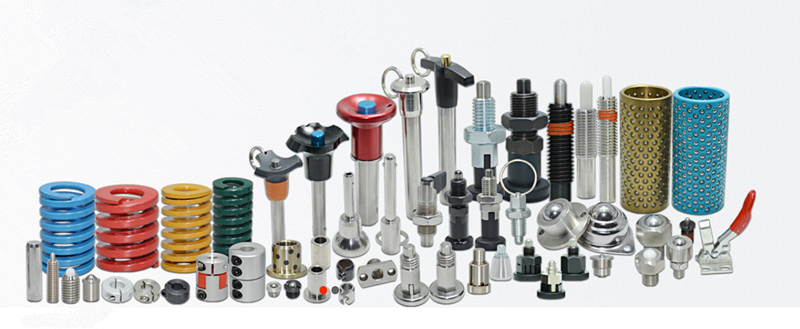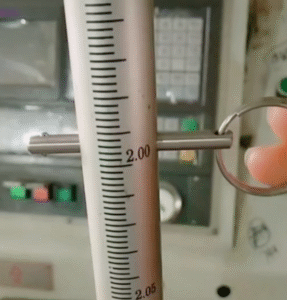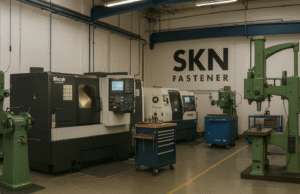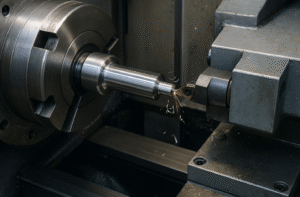Штифты с шариковым замком против штифтов с кнопкой
В мире быстросъемного крепежа выбор правильного штифта может существенно повлиять на производительность, безопасность и продуктивность. Среди множества доступных типов, штифты шарикового замка и кнопочные штифты являются двумя наиболее часто используемыми в промышленности, аэрокосмической отрасли и машиностроении. Хотя оба они служат одной и той же основной цели - быстрому креплению без использования инструментов, - их структура, функциональность и идеальные области применения различаются в значительной степени.
Если вы являетесь инженером, менеджером по закупкам или покупателем комплектующих, рассматривающим эти варианты, данное руководство поможет вам понять разницу между шариковым замком и кнопочным штифтом, а также то, когда следует предпочесть один из них другому.
Что такое штифты с шариковым замком?
Шариковые стопорные штифты, часто называемые стопорными штифтами, - это крепежные элементы, предназначенные для высокопрочного и многократного использования. Основной особенностью шарикового стопорного штифта является его подпружиненные шарики на кончике. Когда штифт вставляется в отверстие, эти шарики втягиваются, а затем расширяются наружу, чтобы надежно зафиксируйте штифт. Чтобы извлечь булавку, пользователь нажимает на кнопку кнопку или потянуть за кольцо на противоположном конце, который втягивает шарики, обеспечивая легкое извлечение.
Ключевые характеристики:
- Механизм блокировки: Подпружиненные стальные шарики
- Операция: Вставьте, чтобы заблокировать, нажмите кнопку или потяните за кольцо, чтобы освободить
- Стили захвата: Т-образная рукоятка, кольцевая рукоятка, Г-образная рукоятка, головка с кнопкой
- Типичные материалы: Нержавеющая сталь, легированная сталь, алюминий
- Размеры: Доступны различные диаметры (обычно 1/4″, 3/8″, 10 мм и т.д.).
Преимущества:
- Высокая прочность на сдвиг и долговечность
- Надежная, устойчивая к вибрациям блокировка
- Подходит для многократных циклов
- Может использоваться в тяжелых и высокоточных приложениях
Что такое кнопочные штифты?
Кнопочные штифты - это тип быстроразъемного крепежа, в котором используется внутренний механизм блокировки активируется Кнопка заподлицо или приподнятая на верхней части булавки. Когда кнопка не нажатаФиксатор удерживает штифт на месте. При нажатии механизм втягивается, позволяя плавно вставить или извлечь штифт.
В отличие от штифтов с шариковым замком, в которых используются видимые шарики для боковой фиксации, штифты с кнопкой более компактность и визуальная чистотаБлагодаря этому они подходят для применения в условиях эстетики и ограниченного пространства.
Ключевые характеристики:
- Механизм блокировки: Внутренний выдвижной стержень или пружинный плунжер
- Операция: Нажмите кнопку, чтобы вставить или вынуть
- Стили захвата: Головка с кнопкой заподлицо, головка грибовидного типа
- Типичные материалы: Нержавеющая сталь, анодированный алюминий
- Размеры: Варьируется; часто настраивается для конкретных систем
Преимущества:
- Низкопрофильная конструкция
- Простое управление одной рукой
- Чистый внешний вид (без выступающей ручки)
- Идеально подходит для компактных узлов
Сравнение бок о бок
| Характеристика | Штифты с шариковым замком | Кнопочные штифты |
|---|---|---|
| Механизм блокировки | Подпружиненные боковые шарики | Внутренний выдвижной запорный стержень |
| Действие релиза | Потяните за кольцо или нажмите верхнюю кнопку | Нажмите на кнопку смыва/закрытия |
| Дизайн профиля | Может иметь ручку или кольцо (громоздкий) | Компактная низкопрофильная головка |
| Прочность и грузоподъемность | Обычно выше (для промышленных нагрузок) | Умеренный; зависит от дизайна |
| Операция | Две руки (вставка и вытягивание) в некоторых версиях | Управление нажатием одной рукой |
| Лучшее для | Промышленные установки, рассчитанные на тяжелые условия эксплуатации и многократное использование | Узкое пространство, легкий вес, эстетичное использование |
| Стоимость | Обычно выше из-за механической сложности | Обычно ниже для стандартных конфигураций |
| Общие отрасли | Аэрокосмическая промышленность, тяжелое оборудование, автоматизация | Медицинские приборы, электроника, транспорт |
Когда следует выбирать штифты с шариковым замком?
Штифты с шариковым замком лучше всего подходят для применения в тех случаях, когда:
- Высокая грузоподъемность необходимо
- Сборка должна выдерживают вибрацию
- Вам необходимо часто собирают/разбирают компоненты
- Безопасность и структурная целостность - главная задача
- Вы предпочитаете видимый и тактильный механизм блокировки
Примеры применения:
- Крепление компонентов в приспособлениях для обслуживания самолетов
- Фиксация деталей пресс-формы в машинах для литья пластмасс
- Позиционирование автоматических манипуляторов в роботизированных системах
- Подключение навесного оборудования вилочного погрузчика или панелей кузова грузовика
Штифты с шариковым замком также часто встречаются MIL-SPEC или аэрокосмические стандартычто делает их идеальными для регулируемых отраслей промышленности.
Когда кнопочные штифты являются лучшим вариантом?
Выбирайте кнопочные штифты, если ваш проект требует их использования:
- Низкопрофильный внешний вид (без Т-образной рукоятки или кольца)
- Управление одной рукой с минимальными усилиями
- Установка в тесные или ограниченные пространства
- Упор на эстетику или эргономику
- Легкие грузы или среднее крепление
Примеры применения:
- Складные столы и модульные дисплеи
- Медицинские тележки или диагностические приборы
- Легкие корпуса или съемные панели
- Сиденья и оборудование для общественного транспорта
Кнопочные штифты часто встречаются в отраслях, где наряду с функциональностью ценится дизайн и эргономичность.
Другие факторы, которые следует учитывать
1. Окружающая среда и выбор материала
Если вы работаете в морская или коррозионная средаПредпочтительно использовать нержавеющую сталь (особенно 316). Для аэрокосмической отрасли или применения, чувствительного к весу, алюминий или титан может быть более подходящим.
2. Бюджет и объем
Штифты с шариковым замком обычно стоят дороже из-за прецизионных компонентов. Для крупных проектов, требующих больших затрат, где не требуется особая прочность, кнопочные штифты могут предложить лучший баланс между производительностью и ценой.
3. Безопасность и вибрация
В условиях повышенной вибрации (например, в движущемся оборудовании, транспортных средствах) штифты с шариковым фиксатором обеспечивают превосходную прочность фиксации и устойчивость к расшатыванию. Кнопочные штифты могут потребовать особенности вторичного удержания в таких сценариях.
Параметры настройки
Как шариковый замок, так и кнопочный штифт могут быть изготовлены по индивидуальному заказу:
- Длина и диаметр
- Материалы (сталь, алюминий, пластик и т.д.)
- Обращайтесь с формами и цветами
- Прочность фиксации и натяжение пружины
- Клеймо или маркировка деталей
Обсуждение конкретной задачи с производителем поможет обеспечить правильную конфигурацию и соблюдение допусков.
Заключение: Какой из них выбрать?
Не существует универсального ответа. Ваш выбор между штифты шарикового замка и кнопочные штифты должны основываться на четком понимании требований вашего приложения.
Выбирайте штифты с шариковым замком, если:
- Вам нужна высокая прочность и долговечность
- Применение предполагает многократные циклы и высокую вибрацию
- Безопасность и надежность конструкции не подлежат обсуждению
Выбирайте кнопочные штыри, если:
- Вам нужно изящное, компактное крепление
- Эргономичное использование одной рукой имеет большое значение
- Требования к нагрузке умеренные
- Пространство ограничено или эстетика имеет значение
Оба типа обеспечивают удобство монтажа и демонтажа без использования инструментов, однако они отвечают разным промышленным потребностям. Если вы все еще не уверены, обратитесь к квалифицированному поставщику или попросите образцы для тестирования.
В [Название вашей компании] мы предлагаем быстросъемные штифты с шариковым замком и кнопкой из различных материалов и конфигураций, с возможностью доставки по всему миру и OEM-изготовления на заказ. Свяжитесь с нами сегодня, чтобы получить предложение или техническую рекомендацию, соответствующую вашему применению.





